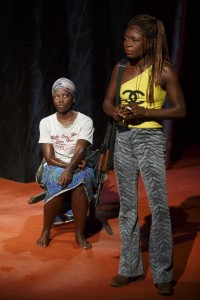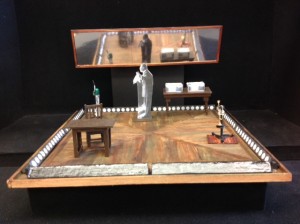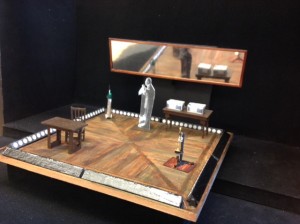 “Melancholy is at the bottom of everything, just as at the end of all rivers is the sea.”
“Melancholy is at the bottom of everything, just as at the end of all rivers is the sea.”
Henri-Frédéric Amiel, Journal intime (trans. Mrs. Humphry Ward)
Terry Teachout on the arts in New York City
Here’s my list of recommended Broadway, off-Broadway, and out-of-town shows, updated weekly. In all cases, I gave these shows favorable reviews (if sometimes qualifiedly so) in The Wall Street Journal when they opened. For more information, click on the title.
BROADWAY:
• An American in Paris (musical, G, too complex for small children, reviewed here)
• Fool for Love (drama, R, closes Dec. 13, reviewed here)
• Fun Home (serious musical, PG-13, most performances sold out last week, reviewed here)
• A Gentleman’s Guide to Love & Murder (musical, PG-13, closes Jan. 17, reviewed here)
• Hamilton (musical, PG-13, all performances sold out last week, reviewed here)
• Hand to God (black comedy, X, absolutely not for children or prudish adults, closes Jan. 3, reviewed here)
• The King and I (musical, G, perfect for children with well-developed attention spans, reviewed here)
• Matilda (musical, G, reviewed here)
• Les Misérables (musical, G, too long and complicated for young children, reviewed here)
• On Your Feet! (jukebox musical, G, nearly all performances sold out last week, reviewed here)
• Spring Awakening (musical, PG-13/R, closes Jan. 24, reviewed here)
• Sylvia (comedy, PG-13, closes Jan. 24, reviewed here)
OFF BROADWAY:
• Alfred Hitchcock’s The 39 Steps (comedy, G, ideal for bright children, remounting of Broadway production, closing Jan. 3, original production reviewed here)
• The Fantasticks (musical, G, suitable for children capable of enjoying a love story, reviewed here)
• The Flick (serious comedy, PG-13, too long for young people with limited attention spans, reviewed here)
 CLOSING NEXT WEEK OFF BROADWAY:
CLOSING NEXT WEEK OFF BROADWAY:
• Eclipsed (drama, PG-13, closes Nov. 29, reviewed here)
CLOSING SATURDAY IN BOSTON:
• Saturday Night/Sunday Morning (drama, PG-13, reviewed here)
CLOSING SUNDAY IN CHICAGO:
• The Price (drama, PG-13, reviewed here)
CLOSING SUNDAY OFF BROADWAY:
• First Daughter Suite (serious musical, PG-13, reviewed here)
I’ll be flying to Chicago in two weeks to start rehearsing the Court Theatre’s upcoming production of Satchmo at the Waldorf, which opens in January. We’ve got a lot to do between now and then, but one very big thing is out of the way: John Culbert has completed his set design for the show.

 Charles Newell, the director, is opting, as is his wont, for a more conceptual approach to Satchmo. According, John’s set (whose model is pictured at right) is considerably more abstract than the one that Lee Savage designed for Gordon Edelstein’s production, in which he sought to reproduce as closely as possible the physical appearance of Louis Armstrong’s 1971 Waldorf-Astoria dressing room.
Charles Newell, the director, is opting, as is his wont, for a more conceptual approach to Satchmo. According, John’s set (whose model is pictured at right) is considerably more abstract than the one that Lee Savage designed for Gordon Edelstein’s production, in which he sought to reproduce as closely as possible the physical appearance of Louis Armstrong’s 1971 Waldorf-Astoria dressing room.
I still remember with undiminished clarity the morning in December of 2008 when Paul Moravec and I got our first look at Hildegard Bechtler’s set designs for the Santa Fe Opera premiere of The Letter:
It looked like a giant-sized doll’s house, right down to the tiny figures that represented the various characters. We gaped at the model, temporarily stunned into silence. I know how it feels to see the design for the dust jacket of a book that I’ve written, but that’s different: the cover is not the book. An opera, on the other hand, truly exists only in performance, and must be created anew each time it is produced: the score is not the show. As I saw how Hildegard had transformed my libretto into a three-dimensional object, a Biblical phrase popped into my mind: Thus the word was made as flesh.
 I’ve undergone the same kind of experience several more times since then, but it hasn’t grown any less exciting. When I opened Charlie’s e-mail this morning and looked at the photographs, I felt like jumping up and down. Yes, John’s set is totally different from Lee’s naturalistic vision of what Satchmo would look like on stage in New England and off Broadway. But it’s neither better nor worse: it is, quite simply, a different way of seeing Satchmo, one that thrills me every bit as much as the old way.
I’ve undergone the same kind of experience several more times since then, but it hasn’t grown any less exciting. When I opened Charlie’s e-mail this morning and looked at the photographs, I felt like jumping up and down. Yes, John’s set is totally different from Lee’s naturalistic vision of what Satchmo would look like on stage in New England and off Broadway. But it’s neither better nor worse: it is, quite simply, a different way of seeing Satchmo, one that thrills me every bit as much as the old way.
It won’t be the last way, either: Michael Amico, who is designing the set for the Palm Beach Dramaworks production of Satchmo that I’ll be directing in May, is approaching the task from yet another angle, one that reflects my own thinking about how the play should look. Still, that doesn’t mean it’ll be right. Even though I wrote the script, I don’t think of my production as somehow being “righter” than its predecessors. It, too, will be nothing more—or less—than a different way of seeing Satchmo at the Waldorf, and I’ll be just as excited when I see Michael’s sketches for the first time.
That’s part of what makes theater so uniquely special an art form: no matter how familiar the script may be, a play is different every time you do it. If you’re the kind of writer who squirms at such a thought, you’d better stick to novels. Me, I thrive on the electrifying uncertainty of collaboration, and I bless Lee, John, and Michael (not to mention William Elliott, who designed Satchmo’s original 2011 production in Orlando) for giving me the priceless gift of surprise.
I was a small-town second-grader on November 22, 1963. My teacher, Jackie Grant, told the class that the president had been shot and killed, and then we all went home. For me, home was a block away from the classroom door, but my mother still drove to the school to pick me up, and my family spent much of the rest of the long weekend watching television. That much I remember, but I have no direct recollections of any of the TV images, except for this: I went to the kitchen to get a glass of milk just before Oswald was shot, and returned to the living room to find chaos on the screen.
That’s it. Not many memories, and no trauma at all. Which makes sense: I was born in 1956, the exact midway point of the baby boom, making me just too young to have been marked by the JFK assassination or to have served in Vietnam. In both of those respects, we younger baby boomers are more like Gen-Xers than our older brothers and sisters….
Read the whole thing here.
| M | T | W | T | F | S | S |
|---|---|---|---|---|---|---|
| 1 | 2 | |||||
| 3 | 4 | 5 | 6 | 7 | 8 | 9 |
| 10 | 11 | 12 | 13 | 14 | 15 | 16 |
| 17 | 18 | 19 | 20 | 21 | 22 | 23 |
| 24 | 25 | 26 | 27 | 28 | ||
An ArtsJournal Blog